| SOIL,
FOOD, & PEOPLE CONFERENCE
March 27-29, 2000
GROW BIOINTENSIVE conference on the U.C. Davis campus
Home
| Intro | Presentations
| Breakout Sessions | Friends:
Old & New | Sponsors
PRESENTATIONS
GROW BIOINTENSIVE® Applications Worldwide
Julian Gonsalves | Irina
Kim | Juan Manuel Martinez | Emmanuel
Omondi
Fernando Pia | Moises
Cuevas Vasquez | Carol Vesecky
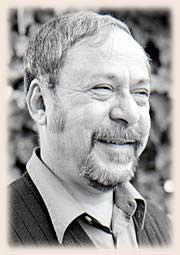 |
Julian Gonsalves works for the
International Institute of Rural Reconstruction and promotes
GROW BIOINTENSIVE practices in the Philippines. |
Gonsalves said that he read How To Grow More Vegetables
over 20 years ago, and attended the 1981 conference co-sponsored
by Ecology Action while still a student at Cornell. He stated that
attending was the best decision he ever made: "It transformed
my life and work."
He returned to the Philippines during the sugar
crisis, when world sugar prices had plummeted. Sugar workers on
the Island of Negros were suffering severely from the crisis. Gonsalves
said that he was able to use GROW BIOINTENSIVE as an entry point
in teaching people to grow their own food.
The program was so successful that the government
redistributed 5,000 acres of land to people for food growing and
eventually initiated a GROW BIOINTENSIVE gardening program in the
schools. Since that time, 23,000 family gardens have been started.
Gonsalves said that the typical garden has 2 double-dug
beds with vegetables grown along the fence line and on trellises.
A row of trees is planted to provide leaves for compost.
He stated that in tropical climates, organic matter
is depleted rapidly, so they suggest that compost be placed deeper
in the soil than normally. Liquid manure is also used because heavy
rains leach nutrients out of the soil quickly.
Gonsalves emphasized that the IIRR functions
as a catalyst. They train the people who train others, and in this
way, 3,000 to 5,000 people a year are taught.
top
 |
Irina Kim is
a soil scientist and teacher of GROW BIOINTENSIVE from Chirchik,
Uzbekistan. She asked to be given time to speak to share her
experiences. |
Kim first called up John Jeavons and presented
him with a traditional robe and hat, as well as hats for his wife
and daughter.
She then described Uzbekistan as a country about
1/100th the size of the U.S. that has economic problems.
In 1994 she received the only copy of the Russian
translation of How To Grow More Vegetables in her country. Kim said
that she immediately understood its importance and it became like
a sacred reference for her. She knew she had to spread the information
as quickly as possible.
Kim was a high school teacher, and she received
permission to teach GROW BIOINTENSIVE as a subject in school. She
also spread the word through the newspapers, magazines and on television.
She wanted this to be a practical skill, too, and therefore she
organized a club for children from 26 schools.
They worked for a long time, from kindergarten
students through the whole school population. There was only the
one book, and she also used it to teach older people twice a week.
Kim said how powerful it is "to think we
can grow our food at our own home - it will save us from starvation."
She expressed her gratitude to the volunteers from the United States
who have come to Uzbekistan to help her teach courses.
[Editor's Note: Addendum from another writing
of Kim's that came to us through Carol Vesecky after the conference:
My experience over five years of studying and
teaching the GROW BIOINTENSIVE method to students and adults has
proven the importance of this technology for Uzbekistan.
I have had positive results in the rooting, growth,
development, and yield of vegetable crops, and have also observed
water conservation: for tomato, cabbage, and pepper, 97%-100%
of the transplants took root in the GROW BIOINTENSIVE beds, while
only 70%-90% took root in the traditional beds.
Crops in the GROW BIOINTENSIVE beds outstripped
the traditional by 150%-200%. GROW BIOINTENSIVE yields for tomato
and cabbage were 1.5 times higher. The traditional beds had to be
watered twice as frequently as the GROW BIOINTENSIVE beds.]
top
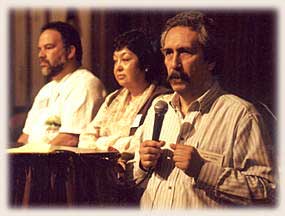
Juan Manuel Martinez is the director of ECOPOL, a
nonprofit organization responsible for initiating and coordinating
all GROW BIOINTENSIVE activity in Mexico and Latin America.
|
| The speakers from Latin America
brought much heart and inspiration to the conference. From left
to right: Padre Julio, Mercedes Torres, and Juan Manuel Martinez. |
Martinez said that he first was introduced to
GROW BIOINTENSIVE in 1983, after investigating several types of
sustainable small-scale agricultural systems. The problem with many
of them was their dependence on chemicals and outside inputs.
He found that GROW BIOINTENSIVE could help people
be independent because they could use resources from within their
community. To prove its worth, he tried it out in one of the most
difficult areas that had poor soil and a high rate of malnutrition
and infant mortality.
Martinez stated that after 5 years of intensive
work in this area, first and second degree malnutrition had disappeared
and infant mortality was reduced. He pointed out that this was not
entirely due to GROW BIOINTENSIVE but that it was instrumental.
Martinez said that 63% of his country is arid,
only 12% is cultivated and of that 12% only 3% is fertile and needs
no irrigation. And this area, he stated, produces export crops.
Martinez gave a slide show of some of the GROW
BIOINTENSIVE work in Mexico, including with the Tarahumara Indians
in Chihuahua state. He pointed out that GROW BIOINTENSIVE is very
similar to the traditional farming methods of the Tarahumara, and
that is the reason it has been so readily accepted by them.
He cited the remarkable figure that about 7 million
people in Mexico have been trained in GROW BIOINTENSIVE mini-farming
practices during the last 11 years.
Martinez ended by saying, "The problems of
the world cannot be solved by skeptics or pessimists. We need men
and women who can dream things that have not yet happened and who
ask themselves 'why not.'"
top
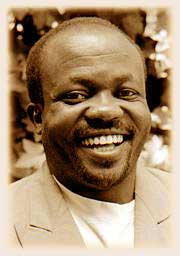 |
Emmanuel Omondi is the director
of Manor House Agricultural Centre near Kitale, Kenya. |
Omondi showed slides during the course of his
presentation to illustrate the many activities of the Centre.
He mentioned that rapid population growth and
less-than-optimal farming techniques have contributed to declining
land quality. He stated that a recent study funded by the World
Bank indicated that 47% of people in rural areas are "absolutely
poor." The study also showed that 60% of Kenyans grow their
own food.
Omondi went on to say that for 15 years Manor
House has been working with the rural poor. The Centre offers a
2-year certificate course in GROW BIOINTENSIVE Agriculture (BIA),
as well as 3-month and 6-week courses and 1-week workshops for farmersÕ
groups and others.
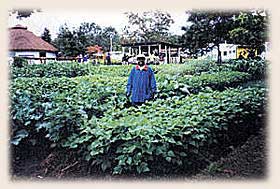
Emmanuel Omondi in garden.
Just before the start of the conference, Manor
House held a field day on its grounds. It was in conjunction with
graduation ceremonies for those who had completed the 2-year course.
Omondi said that about 200 to 300 people generally attend this ceremony,
and this is the number they were expecting, but that this year 1,000
people showed up.
He said they were very encouraged because they
believe it shows that many people in Kenya are waking up to the
need for this kind of high-yield, resource- conserving agriculture.
When Manor House started in 1984, they were the
only ones in Kenya teaching BIA. Now 40 organizations are teaching
it. As of now, over 70,000 Kenyans have been taught directly and
indirectly.
Omondi discussed a research project that Manor
House had initiated among the farmers of Kakamega. Some of the farmers'
comments at the end of the project were:
- they had experienced higher productivity
using GROW BIOINTENSIVE,
- their produce was softer, more palatable,
and of higher quality,
- their health had improved with the addition
of more fruits and vegetables to their diet, and
- their costs using GROW BIOINTENSIVE were
about half of the conventional method costs.
Omondi closed by stating he believes that
"GROW BIOINTENSIVE is the answer to food needs now and forever."
top
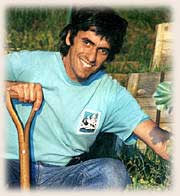 |
Fernando Pia
is an agronomic engineer, working for the Rural Extension Service
in Patagonia, Argentina. He is the founder and director of CIESA,
the Center for Research and Demonstration in Sustainable Agriculture. |
Pia began with some facts about soil loss in Argentina:
150,000 acres of topsoil have been lost, and in the richest food-growing
areas of Argentina, 100,000 pounds of topsoil are being lost per
acre per year. He then gave a slide presentation which beautifully
illustrated his talk.
Pia traced his frustrations as an agricultural
extensionist who did not have the solutions that would stem the
migration of indigenous Mapuches from their unproductive land to
the cities or to help people from the cities who wanted to farm
but could not afford the costs of land and equipment that conventional
agriculture required.
Pia talked about attending Ecology Action's Three-Day
Workshop in 1993 and liking what he heard as an answer to some of
the above problems but being skeptical of the results. When he returned
home, he established CIESA and after 3 years of researching the
GROW BIOINTENSIVE method, proved to himself and others that Ecology
Action's claims worked, and worked in Patagonia.
Since then, CIESA has given 16 three-day workshops
for 320 participants. It has also successfully trained apprentices
from the most arid parts of Patagonia in GROW BIOINTENSIVE practices.
These individuals subsequently returned home and established GROW
BIOINTENSIVE demonstration gardens in areas with:
- as little as 5 inches of rain per year,
- high winds, and
- frosts in the middle of the warmer growing
season.
Some of the most impressive slides showed green
gardens growing lushly in the midst of a brown landscape, where
Pia said only 16 inches of rain falls per year and winds reach 90
miles per hour.
Pia described yields in his area as 4 times
higher than the regional average for lettuce, 4 times higher for
potatoes, almost 2 times for cabbage and 3 to 4 times for tomatoes.
top
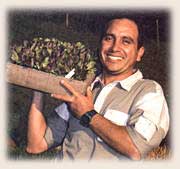 |
Moises Cuevas Vasques
is the director of AALTERMEX, in Texcoco, Mexico, and its training
and research center in organic GROW BIOINTENSIVE methods. |
Moises said that AALTERMEX, started in 1989, is
a collaborative effort of the University of Chapingo, ECOPOL, Ecology
Action and the University of Mexico City. The organization is made
up of professors from the two universities, producers, and individuals.
Its purpose is to help small producers towards
self-sufficiency, being aware of all the current problems:
- soil degradation,
- dependency on chemical inputs,
- high costs,
- unemployment, and
- malnutrition.
Vasques said they were first working with organic
agriculture but that has since become such a confusing term and
they found that GROW BIOINTENSIVE means sustainability. It does
because it is based on the scientific principles of agro-ecology,
including management of soil, fertility, vegetable nutrition, and
water, and it is integrated with the existing environmental, social
and economic conditions.
Vasques then showed the results of their research
as a series of graphs, comparing yields and prices received for
domestic and foreign sales for various crops, with and without irrigation,
using both conventional and GROW BIOINTENSIVE methods, in which
GROW BIOINTENSIVE consistently outperformed conventional.
Vasques described AALTERMEX's training courses,
which last from one month to 2 years. The universities have also
given credit and non-credit courses in GROW BIOINTENSIVE. In the
last 10 years, 3,500 people have been taught. The University of
Chapingo has been researching the GROW BIOINTENSIVE method for the
last 5 years and has concluded that it is a method which works for
the small family farmer.
Yields in the 1996-1997 growing season in AALTERMEX
test areas demonstrated Swiss chard yields that were 1.34 times
the Mexican average, beets 2.6 times, broccoli 1.46 times, summer
squash 3.58 times, onions 6.29 times, radishes 2.53 times and carrots
2.69 times.
1997 data also showed a vegetable crop income
potential of US$122 to $1,381 per 1,785 square feet (192 square
meters); and US$6,345 to $71,931 per 2.13 acres (10,000 square meters)Ðdepending
on the type of marketing done. [EditorÕs Note: The legal
urban income in Mexico is approximately US$2,100 and for rural areas
is approximately US$1,000.]
Vasques showed a fax he had just received from
his Department of Agro-Ecology at the University stating it wants
to start offering GROW BIOINTENSIVE as a core course.
top
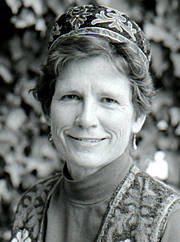 |
Carol Vesecky
is the Director of GROW BIOINTENSIVE for Russia. In the mid-1980's,
she became involved in citizen diplomacy activities that led
to her current work promoting GROW BIOINTENSIVE through Russian
language publications and workshops in the former Soviet Union. |
Vesecky talked about small-area dacha gardening,
where city dwellers grow food on suburban plots.
She said that 50% of urban people now have access
to these plots and they are particularly necessary because approximately
30 percent of Russians live in poverty (70% live worse than they
did in Soviet times), and there is a lack of affordable food in
stores. People grow virtually all of their vegetables, fruits and
berries - 50% of their diet - in this way.
Vesecky said that because of the importance of
dacha growing to the people, she helped get How To Grow More Vegetables
translated into Russian. (The translation of the fourth edition
was first published in 1993 and the translation of the fifth edition
in 1999.)
Later in her presentations, she showed slides
of some of these dachas and their bounty, including beautiful canned
fruit and vegetables, which help feed Russians during the winter.
She stressed that Russians truly are master gardeners,
who start seeds on their windowsills in February and plant them
out into coldframes in their dacha gardens during April and May.
Vesecky also spoke about the GROW BIOINTENSIVE
efforts going on throughout the former Soviet Union. She said there
are currently 7 small GROW BIOINTENSIVE centers that are actively
teaching and researching the method. These include ones in Chirchik,
Uzbekistan; Bryansk, Russia; Novo-Sin'kovo, near Moscow; St. Petersburg;
and Novosibirsk, Siberia.
Her slides showed some of the participants at
the workshops that have been given in these centers. She mentioned
that a Summer 2000 Workshop Tour will take place again this year.
top |